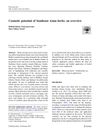TLDR The herbal shampoo with Sapindus emarginatus and Curcuma longa was most liked and effective against bacteria.
This study developed an herbal shampoo using extracts from Cassia alata, Curcuma longa, Lawsonia inermis, Rhinacanthus nasutus, and Sapindus emarginatus, evaluating their antibacterial effects. The combination of Lawsonia inermis and Curcuma longa showed the highest antibacterial activity against Pseudomonas aeruginosa and Staphylococcus aureus, while Rhinacanthus nasutus and Sapindus emarginatus were most effective against Staphylococcus epidermidis. The most effective formulation had a Minimum Inhibitory Concentration of 10⁻⁸ mg/ml. Stability tests indicated significant color changes at high temperatures. Consumer preference tests with 30 participants favored a formulation containing Sapindus emarginatus and Curcuma longa for color, foam, and overall acceptance.
January 2025 in “Green energy and technology”  October 2024 in “Current Trends in Biotechnology and Pharmacy”
October 2024 in “Current Trends in Biotechnology and Pharmacy” The shampoo effectively promotes hair growth and is halal-compliant.
 May 2023 in “Health science reports”
May 2023 in “Health science reports” Coloring shampoos for gray hair may cause gene mutation, reproductive issues, and skin damage, needing stricter regulation and expert consultation.
3 citations
,
January 2023 in “Journal of Hunan University Natural Sciences” The natural shampoo with plant extracts works well like commercial ones but needs more testing.
 57 citations
,
October 2021 in “Journal of ethnopharmacology”
57 citations
,
October 2021 in “Journal of ethnopharmacology” Indian herbal medicine shows promise for treating skin diseases but needs more research to prove effectiveness.
 17 citations
,
February 2015 in “Phytochemistry Reviews”
17 citations
,
February 2015 in “Phytochemistry Reviews” Southeast Asian herbs show promise for skin and hair care, but more research is needed to confirm their effectiveness in cosmetics.
January 2018 in “Turkiye Klinikleri Journal of Dermatology” Commonly used plants in hair products can guide future research and help professionals recommend treatments.
 December 2023 in “Research in pharmacy”
December 2023 in “Research in pharmacy” Phytotherapeutic compounds and supplements can help manage Polycystic Ovarian Syndrome (PCOS).
 December 2021 in “International journal of minor fruits, medicinal and aromatic plants”
December 2021 in “International journal of minor fruits, medicinal and aromatic plants” The document concludes that in Sri Lanka, 25 common plants are traditionally used as home remedies for various health issues due to their medicinal properties.





